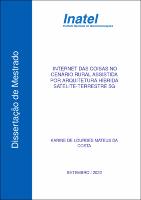| ???jsp.display-item.social.title??? |


|
Please use this identifier to cite or link to this item:
https://tede.inatel.br:8080/tede/handle/tede/237| ???metadata.dc.type???: | Dissertação |
| Title: | Internet das Coisas no Cenário Rural assistida por Arquitetura Híbrida Satélite - terrestre 5G |
| ???metadata.dc.creator???: | Costa , Karine de Lourdes Mateus da  |
| ???metadata.dc.contributor.advisor1???: | Alberti, Antônio Marcos |
| ???metadata.dc.contributor.referee1???: | Alberti, Antônio Marcos |
| ???metadata.dc.contributor.referee2???: | Marins, Carlos Nazareth Motta |
| ???metadata.dc.contributor.referee3???: | Agostinho, Souza Filho |
| ???metadata.dc.description.resumo???: | É inquestionável que os componentes satelitais são essenciais para lidar com os desafios referentes ao suporte a cobertura onipresente, à IoT (Internet of Things) global, as comunicações máquina a máquina, às missões críticas de telecomunicações e ao aumento do tráfego multimídia. Devido a isso, principalmente nos cenários WRAN (Wireless Regional Area Network) e eRAC (enhanced Remote Area Communications), novos paradigmas de arquitetura híbrida satélite-terrestre têm sido explorados. O intuito e ampliar a provisão de serviços para áreas remotas em diversos setores, como ambientes e transportes inteligentes, agricultura, aeronáutico, militar, marítimo, entre outros. Diante disso, esse trabalho teve por objetivo integrar, configurar, investigar e avaliar o desempenho das aplicações remotas IoT operando a partir de uma rede híbrida 5G, contribuindo assim para o avanço do agronegócio em países continentais. Para tanto desenvolveu-se um sistema inteligente para monitorar e controlar a irrigação de uma horta em área rural. O uso da rede híbrida para fornecer conectividade adequada para aplicações WRAN, eRAC e IoT foi confirmado através de um cenário de teste que variam entre 500 ms e 1600 ms. O ambiente de testes desenvolvido constitui-se de uma arquitetura de rede híbrida satélite-terrestre implementada a partir da integração do satélite SES-14 e um par de modems 5G GFDM (Generalized Frequency Division Multiplexing) e de uma aplicação rural IoT, ambas desenvolvidas e implementadas para esse trabalho. |
| Abstract: | Satellite components are unquestionably essential to address the challenges relating to support of ubiquitous coverage, global IoT (Internet of Things), machine-to-machine communications, telecommunications mission-critical, and an increase in multimedia traffic. New paradigms of hybrid satellite-terrestrial architecture have therefore been explored, mainly in WRAN (Wireless Regional Area Network) and eRAC (enhanced Remote Area Communications) scenarios. The aim is to extend the provision of services to remote areas in a variety of sectors, such as smart environments and transport, agriculture, aeronautics, military, and maritime, among others. Therefore, this work integrates, configures, investigates, and evaluates the performance of a remote IoT application operating from a 5G hybrid network, thus contributing to the advancement of agribusiness in continental ountries. For this purpose, an intelligent system was developed to monitor and control the irrigation of a vegetable garden in a rural area. The use of the hybrid network to provide adequate connectivity for WRAN, eRAC, and IoT applications was confirmed through a scenario that connected the cities of Santa Rita do Sapucaí-MG and Hortolândia-SP. Tests in the IoT context presented acceptable results, with round-trip delays between the extreme points of the test scenario ranging from 500 ms to 1600 ms. The test environment consists of a hybrid satellite-terrestrial network architecture implemented using the integration of the SES14 satellite and a pair of 5G GFDM (Generalized Frequency Division Multiplexing) modems with a rural IoT application, both developed and implemented for this work. |
| Keywords: | 5G; Arduino; Áreas Remotas; Arquitetura Híbrida; Conectividade; Fazenda Inteligente; GEO; Integração; IoT; LEO; NodeMCU ESP8266; Satélite |
| ???metadata.dc.subject.cnpq???: | Engenharia - Telecomunicações |
| Language: | por |
| ???metadata.dc.publisher.country???: | Brasil |
| Publisher: | Instituto Nacional de Telecomunicações |
| ???metadata.dc.publisher.initials???: | INATEL |
| ???metadata.dc.publisher.department???: | Instituto Nacional de Telecomunicações |
| ???metadata.dc.publisher.program???: | Mestrado em Engenharia de Telecomunicações |
| Citation: | Costa, Karine De Lourdes Mateus da. Internet das Coisas no Cenário Rural assistida por Arquitetura Híbrida Satélite - terrestre 5G. 2021. [112]. dissertação (Mestrado em Engenharia de Telecomunicações) - Instituto Nacional de Telecomunicações, [Santa Rita do Sapucaí]. |
| ???metadata.dc.rights???: | Acesso Aberto |
| URI: | https://tede.inatel.br:8080/tede/handle/tede/237 |
| Issue Date: | 17-Dec-2021 |
| Appears in Collections: | Mestrado em Engenharia de Telecomunicações |
Files in This Item:
| File | Description | Size | Format | |
|---|---|---|---|---|
| Dissertação V.Final Karine Costa.pdf | Internet das coisas no cenário rural assistida por arquitetura híbrida satélite- terrestre 5G | 31.62 MB | Adobe PDF |  Download/Open Preview |
Items in DSpace are protected by copyright, with all rights reserved, unless otherwise indicated.




